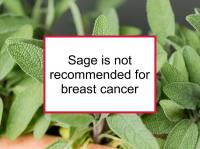Sage refers to the leaves of the plant Salvia officinalis, a member of the mint family. Sage has been found to have antiseptic, antimicrobial, astringent, antioxidant, anti-inflammatory, antifungal, antiviral, hypoglycemic, antiatherogenic and antimutagenic properties. Sage contains numerous biologically active compounds.
These include caffeic acid, camphor, carnosic acid, cineol, epirosmanol, galdosol, gallic acid, genistein, isorosmanol, limonene, luteolin, rosmanol, rosmarinic acid, thujone, thymol, and ursolic acid. Red sage (Salvia officinalis var. rubia) refers to a variety of sage with red leaves which has essentially the same properties as common sage.
Sage has been found to have anti-diabetic effects, reducing levels of serum glucose, triglycerides, and total cholesterol, and increasing plasma insulin in diabetic rats but not in normal rats. Sage has been shown to improve memory retention in both Alzheimer's patients and college-age subjects. However long-term heavy use can cause seizures or other neurological symptoms due to sage's thujone content. Sage should be avoided by those who suffer from epilepsy or other seizure disorders.
Cancer-related effects of consuming sage
Carnosol and carnosic acid, both found in sage, have been shown to arrest human colon cancer cell development at different phases of the cell cycle. Carnosol also has been shown to inhibit carcinogenesis of human prostate cancer cells. Gallic acid has been shown to increase the effectiveness of paclitaxel chemotherapy in ER+/PR+ breast cancer cells.
Luteolin has been found to induce apoptosis (programmed cell death) in triple negative (ER-/PR-/HER2-) breast cancer cells, to reduce ER+/PR+ cell viability in a dose- and time-dependent manner, and to inhibit the growth, proliferation and migration of HER2+ breast cancer cells. Rosmarinic acid has been shown to inhibit proliferation and induce apoptosis (programmed cell death) of triple negative breast cancer cells. Rosmarinic acid has also been reported to reduce doxorubicin-induced cardiomyopathy (heart damage) without reducing its cytotoxic effects against ER+/PR+ breast cancer cells.
Ursolic acid has been shown to inhibit lung colonization of mouse melanoma cells. Ursolic acid has also been reported to inhibit tumor formation and growth in all of the major breast cancer receptor types (ER+/PR+, HER2+ and triple negative). In addition, ursolic acid has been shown to inhibit aromatase and to reverse multidrug resistance in breast cancer cells.
Despite the presence of these chemopreventive micronutrients, we do not recommend sage since it appears to have important hormonal effects, as described below. Better choices would be rosemary, oregano or thyme.
Hormonal effects of sage
Sage is used in several folk medicine traditions for its hormonal effects. Sage has estrogenic effects and is sometimes recommended for menopausal problems, especially hot flashes and night sweats.
Sage is also recommended by some health practitioners to relieve milk oversupply and breast engorgement during weaning and is believed to reduce milk supply by acting directly on hormone receptors. On the other hand, sage is sometimes used to promote lactation. One study reported that rats' given sage extract experienced increases in the number and diameter of mammary gland ducts compared to untreated rats. Sage's reputed ability to influence lactation has not been thoroughly investigated (this action is not normally associated with phytoestrogens). Until this lactation-related effect has been explained, we recommend avoiding all but modest amounts of sage and would advise against regular consumption of sage tea.
Sage is also thought to stimulate the uterus, and is sometimes used during childbirth and to expel the placenta. Therefore, sage should be avoided by women who are pregnant, trying to become pregnant, or nursing.
Additional comments
Red sage root (also known as danshen or salvia root) refers to the root and rhizome of Salvia miltiorrhiza, another plant in the Labiatae family. It is used as in Chinese medicine to treat irregular menstruation, cardiovascular problems, and inflammation, and as a tranquilizer, among other uses. Significant herb-drug interaction have been observed between the dried root and rhizome of Salvia miltiorrhiza and warfarin, aspirin, and digoxin, among others. CYP induction by Salvia miltiorrhiza suggests that it should be avoided during tamoxifen treatment. Salvia miltiorrhiza has also been reported to have potential angiogenic properties.
Sage essential oil (sage oil) is used as a food preservative (for example in liver pâtés), however it is greatly diluted during food processing. Sage essential oil is poisonous and too concentrated to be safely swallowed undiluted.
Drinking sage tea could potentially increase liver damage from some prescription medications and should be avoided by those with liver disease. Sage-drug interactions may occur when taken with drugs designed to treat conditions on which sage appears to act, some psychotropic drugs and painkillers, and other drugs (e.g., oxytocin, nalbuphine, bromocriptine mesylate, ethionamide). Clearly, caution is advised when combining significant amounts of sage or regular sage tea drinking with prescription medications.
Sources of information provided in this webpage
The information above, which is updated continually as new research becomes available, has been developed based solely on the results of academic studies. Clicking on any of the underlined terms will take you to its tag or webpage, which contain more extensive information.
Below are links to 20 recent studies concerning this food and its components. For a more complete list of studies, please click on sage.
